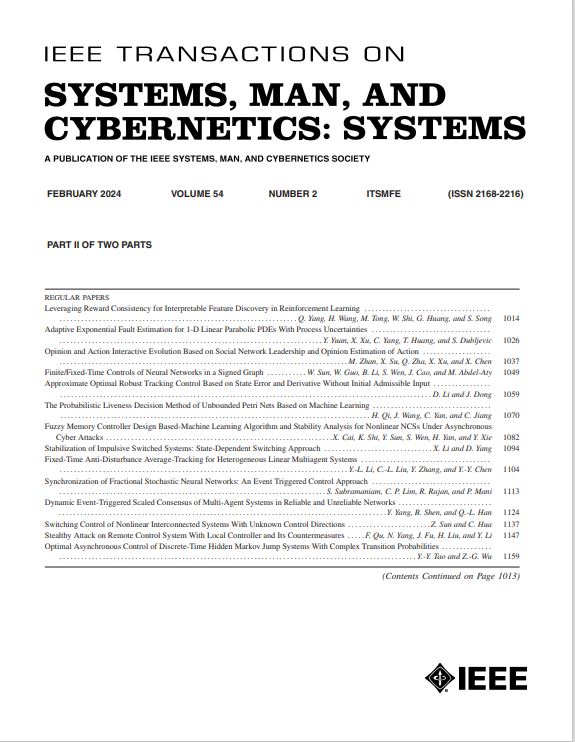Bipartite Complete Synchronization of Fractional Heterogeneous Networks via Quantized Control Without Gauge Transformation
IF 8.6
1区 计算机科学
Q1 AUTOMATION & CONTROL SYSTEMS
IEEE Transactions on Systems Man Cybernetics-Systems
Pub Date : 2025-03-14
DOI:10.1109/TSMC.2025.3546677
引用次数: 0
Abstract
Recently, gauge transformation-based bipartite synchronization has received much interest, but the method of gauge transformation alters the original signed topological structure and the competition or cooperation among individuals is obscured. In addition, the heterogeneity of nodes brings great difficulty and challenge for heterogeneous networks to achieve complete synchronization like homogeneous networks. In this article, without converting signed graph into corresponding unsigned structure via the gauge transformation, the bipartite complete synchronization of heterogeneous fractional networks is explored. Above all, a mathematic model of fractional networks with signed topology and heterogeneous nodes’ dynamics is introduced, in which the topological graph possesses both negative and positive edges to illustrate the competition and cooperation between individuals, and the desired synchronized state is an arbitrarily specified smooth orbit and not necessarily the decoupled state. Additionally, two innovative control schemes with logarithmic quantizer are developed, and several conditions are obtained to reach bipartite complete synchronization of fractional heterogeneous networks just by virtue of the Laplacian matrix of the original signed graph rather than the traditional technique of gauge transformation. The theoretical analysis is eventually confirmed by several numerical results.非规范变换量化控制下分数异构网络的二部完全同步
近年来,基于规范变换的二部同步备受关注,但规范变换的方法改变了原有的签名拓扑结构,模糊了个体间的竞争或合作。此外,节点的异构性给异构网络实现同构网络的完全同步带来了很大的困难和挑战。本文在不通过规范变换将有符号图转换为相应的无符号结构的情况下,研究了异构分数阶网络的二部完全同步问题。首先,引入了带有符号拓扑和异构节点动力学的分数阶网络的数学模型,该模型的拓扑图同时具有正负边来说明个体之间的竞争与合作,期望的同步状态是任意指定的光滑轨道,而不一定是解耦状态。在此基础上,提出了两种采用对数量化器的创新控制方案,并给出了仅利用原始符号图的拉普拉斯矩阵而不是传统的规范变换技术实现分数阶异构网络二部完全同步的几个条件。理论分析最终得到了几个数值结果的证实。
本文章由计算机程序翻译,如有差异,请以英文原文为准。
求助全文
约1分钟内获得全文
求助全文
来源期刊

IEEE Transactions on Systems Man Cybernetics-Systems
AUTOMATION & CONTROL SYSTEMS-COMPUTER SCIENCE, CYBERNETICS
CiteScore
18.50
自引率
11.50%
发文量
812
审稿时长
6 months
期刊介绍:
The IEEE Transactions on Systems, Man, and Cybernetics: Systems encompasses the fields of systems engineering, covering issue formulation, analysis, and modeling throughout the systems engineering lifecycle phases. It addresses decision-making, issue interpretation, systems management, processes, and various methods such as optimization, modeling, and simulation in the development and deployment of large systems.
 求助内容:
求助内容: 应助结果提醒方式:
应助结果提醒方式:


